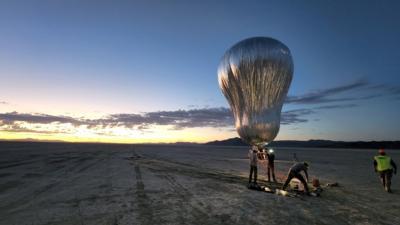Thu, Oct 13, 2022
Atmospheric Assestment System in Development for Venutian Exploration
The Jet Propulsion Laboratory completed the first of a battery of test flights for their prototype aerial robotic balloon.

The system is hoped to help uncover atmospheric conditions on the planet Venus, deploying the balloon into the intense heat, pressure, and corrosive gases found in its environment. The balloon is a part of a concept that pairs it with an orbiting platform outside the atmosphere. The duo would allow the orbiting portion to function as a communications relay while allowing the robotic balloon, or "aerobot" , to descend into the atmosphere proper and act as a submerged analysis platform.
The idea is promising enough for the JPL to begin work on preliminary designs that would see the aerobot make humanity’s best observation of Venus in decades, following up on a balloon-borne survey done underthe Soviet’s Vega mission in 1985. Those balloons lasted only 46 hours before losing power, a record that should be handily outperformed with modern technology - provided, of course, that they’re hardy enough to survive. The ultimate goal for NASA is to create an aerobot that can travel by riding the Venusian winds, circumnavigating the planet for at least 100 days while monitoring the planet with as many sensors as they can pack aboard.
The Jet Propulsion Lab tested the general concept with the assistance of the Near Space Corporation to assess the feasibility of a smaller 1/3 scale demonstrator over Nevada's Black Rock Desert. The test saw the silvery aerobot ascent to 4,000 feet, roughly equivalent to the atmospheric conditions found at 180,000 ft AGL on Venus. The prototype appears to have been a success, ascending and holding altitude before coming back down to earth with the trademark grace of lighter-than-air aircraft.
“We’re extremely happy with the performance of the prototype. It was launched, demonstrated controlled-altitude maneuvers, and was recovered in good condition after both flights,” said robotics technologist Jacob Izraelevitz, who leads the aerobot's development as the JPL principal investigator over flight testing. “We’ve recorded a mountain of data from these flights and are looking forward to using it to improve our simulation models before exploring our sister planet."
More News
Pilot Applied Full Aft Stick And Nose-Up Trim, But The Airplane Remained On The Runway Analysis: The pilot reported that a preflight inspection and flight control checks revealed n>[...]
A Few Questions AND Answers To Help You Get MORE Out of ANN! 1) I forgot my password. How do I find it? 1) Easy... click here and give us your e-mail address--we'll send it to you >[...]
From 2022 (YouTube Edition): Before They’re All Gone... Humankind has been messing about in airplanes for almost 120-years. In that time, thousands of aircraft representing i>[...]
Advanced Air Mobility (AAM) A transportation system that transports people and property by air between two points in the NAS using aircraft with advanced technologies, including el>[...]
Aero Linx: MQ-1B Predator The MQ-1B Predator is an armed, multi-mission, medium-altitude, long-endurance remotely piloted aircraft that is employed primarily as an intelligence-col>[...]
 NTSB Final Report: Douglas A-4K
NTSB Final Report: Douglas A-4K ANN FAQ: Q&A 101
ANN FAQ: Q&A 101 Classic Aero-TV: PBY Catalina--From Wartime to Double Sunrise to the Long Sunset
Classic Aero-TV: PBY Catalina--From Wartime to Double Sunrise to the Long Sunset ANN's Daily Aero-Term (07.01.25): Advanced Air Mobility (AAM)
ANN's Daily Aero-Term (07.01.25): Advanced Air Mobility (AAM) ANN's Daily Aero-Linx (07.01.25)
ANN's Daily Aero-Linx (07.01.25)



